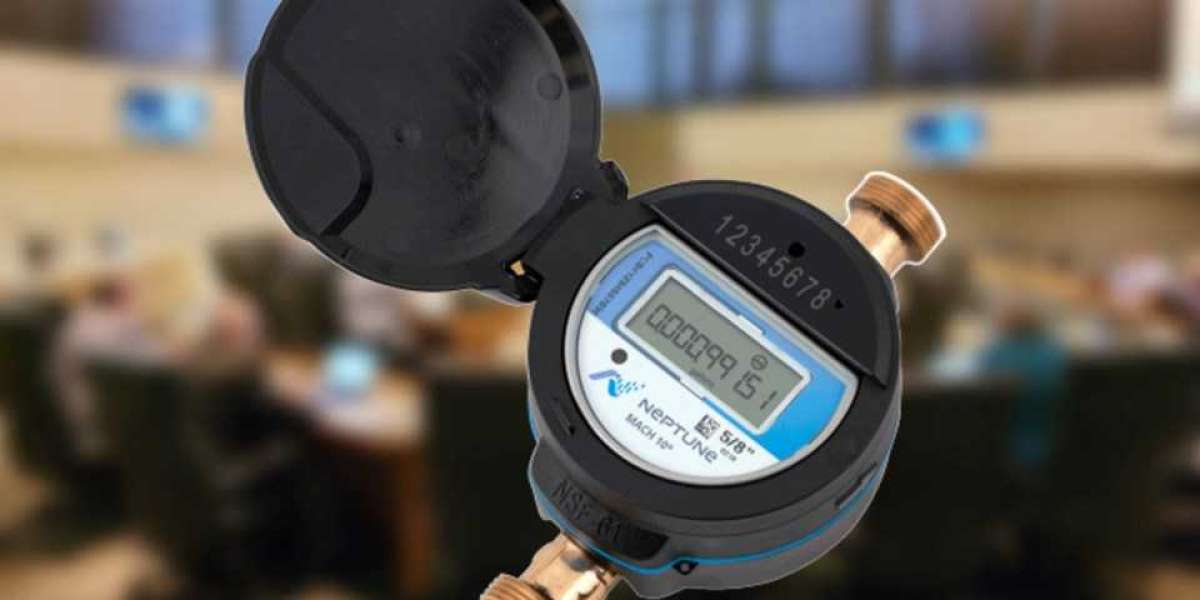Smart water metering systems employ advanced sensors, communication modules, and data analytics to automate the measurement and management of water consumption. These meters offer real-time monitoring, enabling utilities and end-users to track usage patterns, detect leaks, and optimize distribution networks. With features like remote reading, two-way communication, and integration with cloud-based platforms, smart water meters reduce manual intervention, lower operational costs, and improve billing accuracy. Growing demand for sustainable water management, regulatory pressure to curb wastage, and rising adoption of smart city initiatives are driving the need for these devices across residential, commercial, and industrial sectors. In addition, automated meter reading and advanced metering infrastructure deliver critical market insights that support informed decision-making on infrastructure upgrades and resource allocation. As utilities and municipalities shift toward data-driven water management, the market is witnessing increased collaboration among technology providers, system integrators, and service companies.
The smart water metering market is estimated to be valued at USD 5.24 Bn in 2025 and is expected to reach USD 11.51 Bn by 2032, growing at a compound annual growth rate (CAGR) of 11.9% from 2025 to 2032.
Key Takeaways
Key players operating in the Smart Water Metering Market are
- Apator S.A.,
- Aclara Technologies LLC,
- Arad Group,
- BMETERS Srl,
- Badger Meter, Inc.
These market companies collectively account for significant industry share and lead the competitive landscape with comprehensive product portfolios. Their continuous investments in RD and strategic partnerships enhance their market positions and facilitate expansion across key regions. Detailed market research indicates that these key players leverage advanced communication protocols and analytics platforms to address growing demand for efficiency.
Key opportunities in the market include expansion into emerging economies facing water scarcity, integration with smart grid and IoT ecosystems, and cross-sector collaborations on sustainable infrastructure projects. Utilities and municipalities are increasingly seeking turnkey solutions and managed services, presenting lucrative growth avenues. Furthermore, partnerships with cloud service providers and data analytics firms unlock new business growth strategies, catering to the rising need for actionable market insights.
Technological advancements center on IoT-driven smart water metering solutions that support real-time data transmission over NB-IoT, LoRaWAN, and cellular networks. Enhanced sensors with AI-enabled leak detection algorithms deliver proactive alerts and predictive maintenance capabilities. Such innovations are shaping market trends by improving operational efficiency, reducing non-revenue water losses, and enabling demand-side management. The integration of digital twins and edge computing further accelerates deployment of scalable AMI (Advanced Metering Infrastructure) platforms.
Market Drivers
One of the primary drivers of the Smart Water Metering Market is the urgent need for optimized water resource management amid increasing global water stress. Rapid urbanization and population growth are straining existing distribution networks, resulting in elevated non-revenue water and mounting operational expenditures. Smart meters enable utilities to conduct real-time monitoring, facilitating early leak detection and enabling data-driven water conservation strategies. Regulatory bodies across North America, Europe, and Asia Pacific are enforcing stricter water usage norms and mandating periodic auditing of distribution networks. This regulatory pressure compels municipalities to invest in advanced metering infrastructure to meet compliance requirements while minimizing waste. Moreover, growing customer demand for transparent billing and self-service portals amplifies the business case for smart water meters. By providing granular consumption data and customizable alerts, these solutions foster customer engagement and incentivize responsible water use. Consequently, market dynamics are shifting toward scalable, interoperable metering platforms that support seamless integration with smart grid and IoT frameworks, driving sustained market growth and encouraging further innovation in analytics-driven water management.
Challenges, SWOT Overview and Geographical Context
The smart water metering market faces a complex set of challenges that span technical, regulatory and operational domains. From an infrastructure standpoint, utilities often struggle with retrofitting legacy pipelines and integrating sensors in remote areas. Interoperability issues between communication protocols create hurdles for seamless connectivity, while data security concerns around wireless networks demand stringent safeguards. These market restraints can slow business growth, even as digital transformation initiatives ramp up.
A brief SWOT overview highlights core dynamics without full detail. Strength lies in advanced analytics platforms that turn consumption patterns into predictive maintenance schedules—boosting efficiency and resource conservation. A major weakness is the high upfront investment required for large deployments, compounded by lengthy return-on-investment cycles that deter some municipal budgets. Among market opportunities, partnerships between meter manufacturers and IoT platform providers can unlock new service models, and evolving regulatory frameworks in water-stressed regions are driving demand. Major threats include cyberattacks on critical infrastructure and potential policy shifts that could delay project approvals.
Geographically, adoption has been most concentrated in highly urbanized regions with aging water networks. Mature utilities in North America and Western Europe have led deployment volumes, leveraging strong market research capabilities and established industry standards. These areas account for the bulk of market revenue due to robust funding mechanisms and well-developed regulatory frameworks. Meanwhile, emerging economies in Asia Pacific and Latin America represent fast-moving frontier segments, where pilot projects are expanding rapidly. In these regions, revenue streams from modular meter roll-outs are gaining traction, backed by public–private partnerships aimed at reducing non-revenue water and improving billing accuracy.
Current Challenges
One pressing challenge is the balancing act between upfront capital expenditure and long-term operational savings. Many water utilities operate under tight fiscal constraints, making it difficult to justify large pilot programs. In parallel, the diversity of communication standards—such as PLC, LoRaWAN and NB-IoT—creates fragmentation, raising the cost of middleware and reducing interoperability. Data privacy also looms large: as devices proliferate, ensuring end-to-end encryption and secure firmware updates becomes critical to prevent unauthorized intrusions.
Furthermore, workforce readiness is a restraint. Transitioning from mechanical to automated meter reading demands new skill sets in data analytics and network management. Training and change-management programs add to project timelines, slowing roll-out. Regulatory hurdles, including lengthy environmental impact assessments and water usage policies, can stall procurement processes. Finally, customer engagement remains a market driver but also a challenge: utilities must educate end users on the benefits of smart metering to secure buy-in, otherwise digital investments may underdeliver on expected consumption reductions.
SWOT Analysis
Strength: Advanced data-driven leak detection and analytics platforms provide utilities with real-time insights into consumption anomalies, boosting asset utilization and reducing non-revenue water losses by up to 30%.
Weakness: High initial capital outlay for hardware, installation and backend integration can deter smaller municipalities with limited budgets; Legacy infrastructure compatibility remains a hurdle as many existing pipelines lack built-in sensor support, driving up customization costs.
Opportunity: Growing emphasis on sustainable resource management and water conservation creates avenues for pilot projects in drought-prone regions; Collaborations between metering vendors and telecom operators are springing up to offer end-to-end connectivity packages, enhancing market share potential.
Threats: Cybersecurity vulnerabilities in unpatched meter firmware expose networks to intrusion risks and data tampering, undermining consumer trust and regulatory compliance; Shifting regulatory landscapes—such as evolving water-tariff policies—may delay approvals or introduce reporting burdens that dampen adoption rates.
Regions with Highest Value Concentration
In terms of value concentration, North America and Europe lead the smart water metering market. In North America, proactive regulatory mandates on water loss management and innovative public funding models have driven major roll-outs. The United States, in particular, has invested heavily in digital meter reading infrastructure, leveraging robust market research and partnerships with technology providers. European utilities—especially in the UK, France and Germany—have prioritized non-revenue water reduction as part of broader sustainability programs, resulting in high-value meter deployments across both public and private networks.
These regions benefit from mature supply chains, clear industry standards and advanced RD ecosystems that accelerate product enhancements. Utilities in these areas often adopt full-scale, city-wide programs rather than piecemeal pilots, which results in larger contract values and demonstrable business growth metrics. Strong incentives, combined with well-defined market growth strategies, ensure that a significant portion of global revenue is generated here. Additionally, established service providers offer comprehensive maintenance and analytics platforms, reinforcing a cycle of recurring revenue and extended asset lifecycles.
Fastest-Growing Region
The Asia Pacific region is emerging as the fastest-growing zone for smart water metering adoption. Rapid urbanization, coupled with acute water scarcity in countries such as India, China and Australia, has intensified the push for efficient consumption monitoring. Governments and private utilities are investing in pilot programs that leverage cost-effective IoT connectivity and cloud-based analytics. This surge is underpinned by aggressive urban infrastructure budgets, supportive policy frameworks and public–private partnership models that de-risk deployments.
In Southeast Asia, water-stressed cities like Jakarta and Manila are piloting large-scale roll-outs, motivated by both financial and environmental imperatives. Local meter manufacturers are scaling up production, aiming to capture rising market share domestically and across neighboring countries. Telecom operators are also entering the fray, bundling connectivity services with meter offerings to streamline implementation. The combination of favorable demographics, digital transformation initiatives and growing environmental awareness positions Asia Pacific as the leading frontier market in terms of growth rate, outpacing mature regions in both unit shipments and installed base expansion.
Get this Report in Japanese Language: スマート水道メーター市場
Get this Report in Korean Language: 스마트수도계량시장
About Author:
Ravina Pandya, Content Writer, has a strong foothold in the market research industry. She specializes in writing well-researched articles from different industries, including food and beverages, information and technology, healthcare, chemical and materials, etc. (https://www.linkedin.com/in/ravina-pandya-1a3984191)











